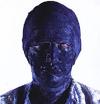Press and Media
The New York Times Magazine – October 26, 1997
NEW YORK TIMES MAGAZINE
THE CONTEMPORARY COLLECTOR'S ART
Kent Logan, a San Francisco collector, amasses his art in true corporate fashion:
with flow charts mapping what he has and what he doesn't.
Hs most extensive acquisitions include, below from left, Francesco Clemente's "Self-Portrait" (1984), Mark Tansey's "Occupation" (1984), Cindy Sherman's "Film Still #6" (1977),
Gottfried Helnwein's "Untitled (Child)" (1996)
and Anselm Kiefer's "Operation Sea Lion" (1975).
Kent Logan makes flow charts of his collection. He maps what he has, what he wants, how it fits. In San Francisco, between visits to New York, he compiles lists for maximum efficiency. This means that, by the time he stops into the Gagosian Gallery on Wooster Street on a recent autumn afternoon dressed in the only pinstripes in SoHo, he has bought and studied the catalogue for Dirons and Jake Chapman's installation "Unholy Libel (Six Feet Under)". Logan already owns works by Damien Hirst and Marc Quinn from the British Sensation school, but he murmurs, "Too much shock, even for me," as he checks out prices at the desk.
No one in the gallery recognizes him. He has a collection of more than 250 works by 90 artists and the ambition of assembling, he says "the definitive collection of the 90s art" with a view toward giving it to a museum someday. But he's too new in the New Yorker art world to be on its radar screen.
Logan collects psychologically charged, media-influenced figurations. Before arriving at the Gagosian Gallery, he bought the 1991 photograph "Fan" to add to his collection of self-portraits by Yasumasa Morimura, a male Japanese artist who photographs himself as figures from art history or female icons of American pop culture. Over the course of an afternoon, Logan will also buy "Good Evening Hamas," a 1997 diptych by Lisa Yuskavage, who paints Playboy cartoon-style dissections of woman as seen through a sex-obsessed male gaze. Logan had to wait nearly a year for a suitably important painting by Yuskavage to become available because Saatchi had got there first.
All through the 80's, Logan worked on Wall Street by day, went home to Greenwhich , Conn., at night and noticed art collecting only from a bemused distance. But in San Francisco, where he is a partner with Montgomery Securities, the art world is faster growing and more welcoming. Besides, by 1991 the art market had crashed. "I thought it would be an opportune time from a market standpoint to be a buyer," he tells me. He acquired Andy Warhol, Jean-Michel Basquiat, Anselm Kiefer and Francesco Clemente - all 80's darlings whose prices were the most depressed. He now sees these artists as anchors to his collection of the young and new.
The collection began to change three years ago, when Logan bought a work by Jerry Kearns, an artist who since 1970 has collaborated with the Brooklyn Black United Front and Lucy Lippard, a feminist critic. Kearns introduced Logan to the New York scene and now acts as his guide and theoretician for a $3,000 monthly retainer. Logan recently joined Kearns on the board of Exit Art, the alternative art space in SoHo. Getting to know artists is the key to Logan's modus operandi. "If the artists see you spend the time to go to their studios, look at the work, engage them in dialogue, then they're going to feel better about saying to a dealer, 'This should go to so-and-so's collection," he says. "I have the opportunity to create a collection that really is a snapshot of a society through time."


